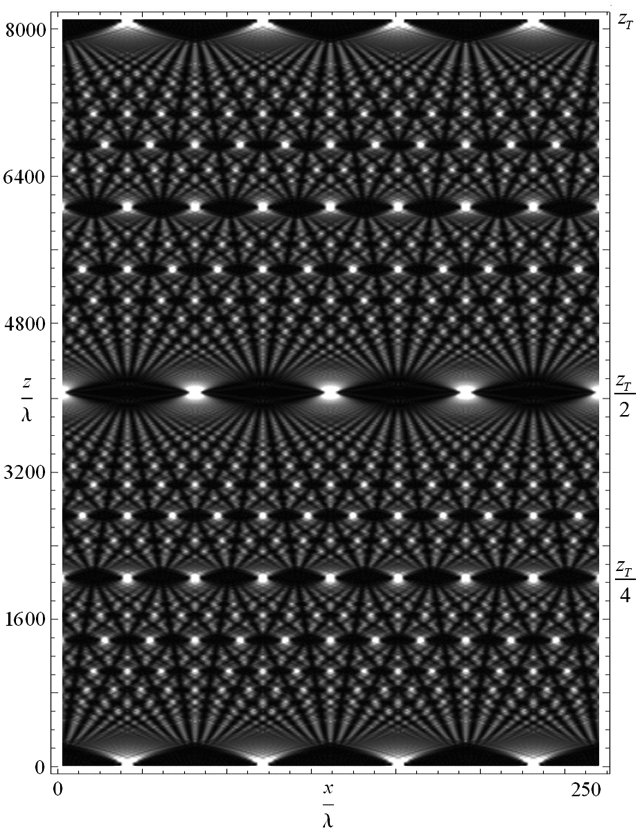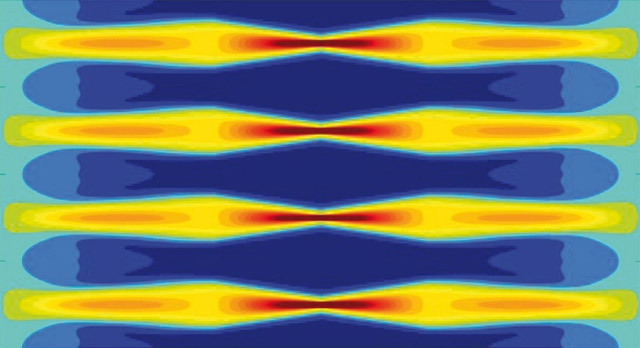Physicists have learned how to lose in diffraction pockets up to 46% of traffic

In 2011, a group of American physicists for the first time demonstrated the effect of a “diffraction” or “time” pocket (temporal cloaking) in waveguide coaxial lasers. Now their colleagues from Purdue University have significantly improved the technology and were able to hide up to 46% of the transmitted information: in hidden mode, they transmitted a stream of 12.7 Gbit / s via optical fiber.
In general, in recent years, scientists have made quite substantial progress in the field of information hiding due to wave interference. By distorting the electromagnetic fields, an effect can be achieved when some regions of space-time fall out of the overall wave pattern (see the Talbot effect ). Thus, any object in these regions becomes invisible to an outside observer.

Talbot effect. If the light passes through several parallel slits (diffraction grating), then interference occurs and "holes" appear with zero light intensity.
')
At first, the effect was obtained on high-frequency microwave radiation, but soon it was also demonstrated in sound waves and in the visible range. Now began experiments with lasers in optical fiber.
In electromagnetic theory there is a certain dualism between space and time. In particular, the diffraction of light rays in space is the mathematical equivalent of the temporal propagation of light in a medium. In other words, diffraction and dispersion are symmetric in space-time.
This immediately leads to the fact that we can create the equivalent of diffractive lenses not only in space, but in time.
The easiest way to understand this, if you imagine the flow of cars on the highway. The first group starts to go faster, and the second group - more slowly. Between them, a kind of pocket is formed, where there is not a single car. In the middle of the road, the first group begins to slow down, and the second group accelerates, so that the pocket disappears, and all the events that took place there are forever erased from history. The same flow of cars arrives at the destination, which was sent from the point of departure. In this analogy, cars are photons, and the freeway is a waveguide. The division of light into groups of frequencies is carried out by changing the voltage in the phase modulator: pockets appear in time, as is the case with a conventional diffraction grating.
From the point of view of physics, we stretch and compress time, so that there is space for the introduction of additional information. A group of physicists from Purdue University under the leadership of Joseph Lukens (Joseph Lukens) managed to "stretch time" by 46%, sending in addition to the main "hidden" stream 12.7 Gbit / s in hidden pockets of time of 36 picoseconds each.

Spatial analogy of the experiment of Joseph Luckens to create pockets in time
Unfortunately, scientists have not yet found a way to take information from such pockets, so that as a result, the transmitted data disappears without a trace from history. In a sense, this is perfect secrecy. Not only the attacker, but even the recipient of the information, cannot intercept the secret data, because the information de facto ceases to exist.
The scientific work “A temporal cloak at telecommunication data rate” was published in the journal Nature on June 5, 2013 (doi: 10.1038 / nature12224).
Source: https://habr.com/ru/post/182434/
All Articles